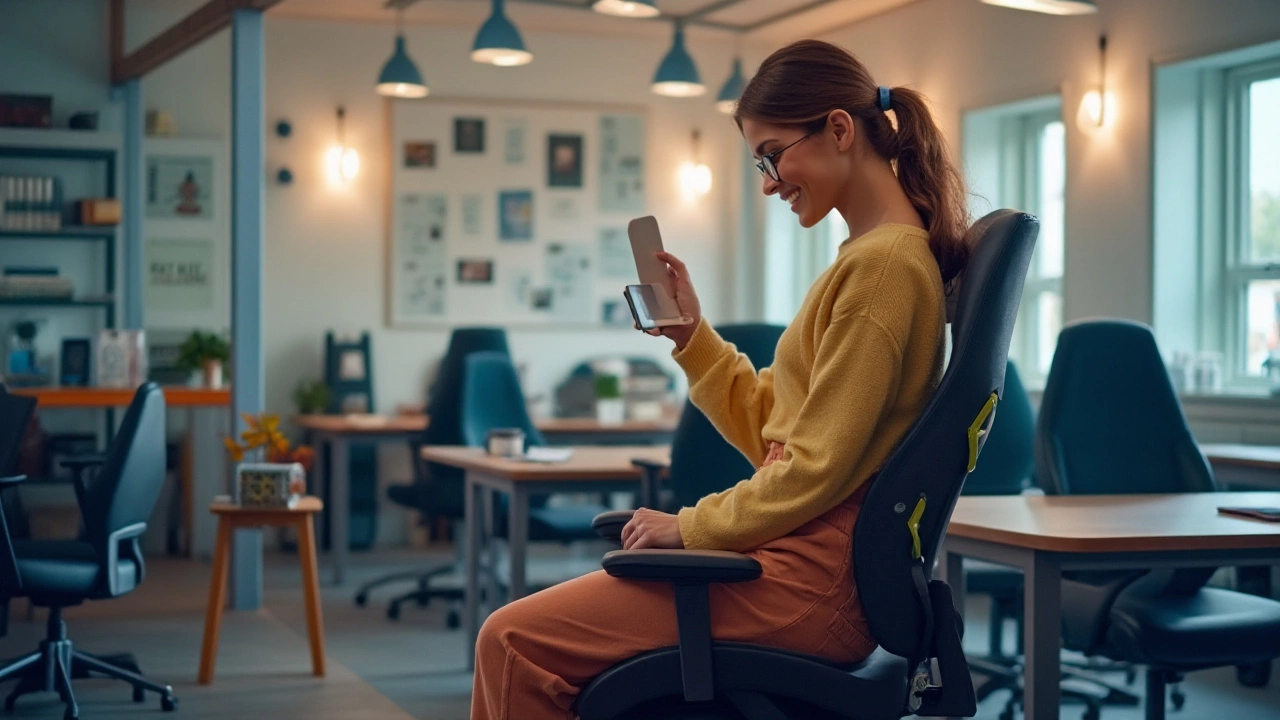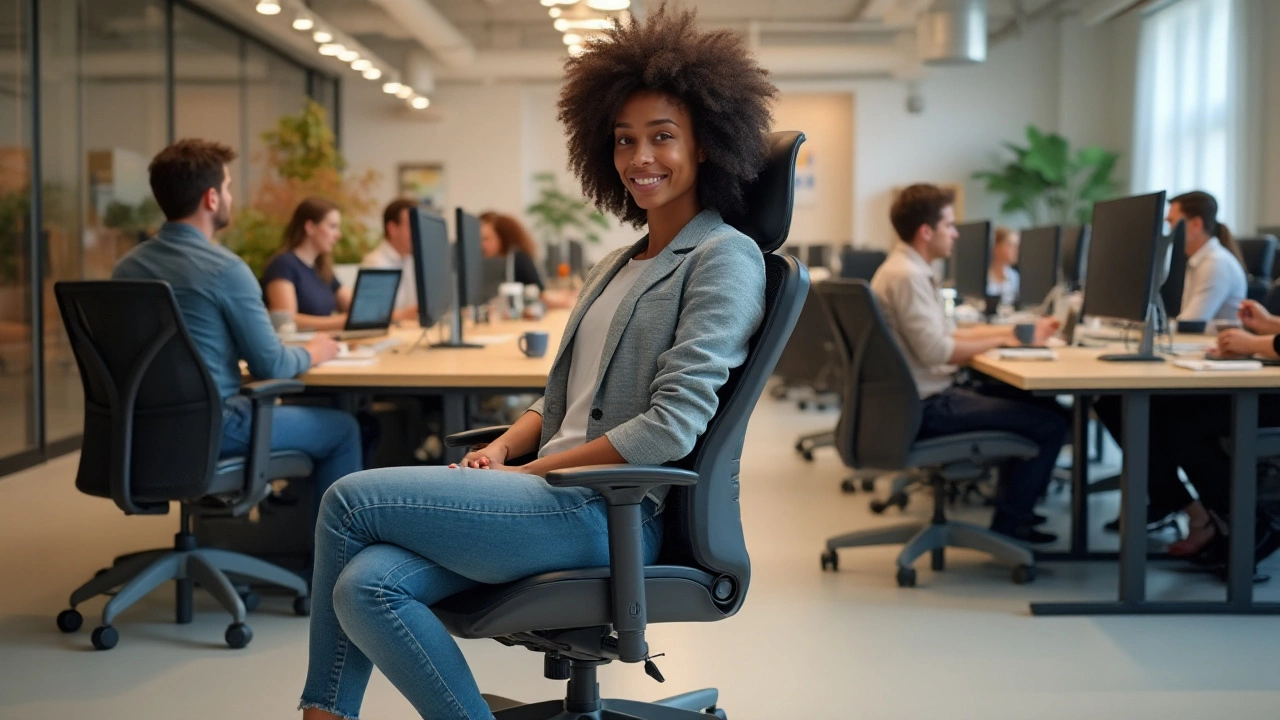 15
Jan,2025
15
Jan,2025
Choosing an office chair might seem straightforward, yet, it holds the key to long-term comfort and productivity. Spending extended hours at a desk requires more than just a place to sit; it demands support for your back, arms, and spine. Not only does a good chair enhance your work experience, but it also significantly impacts your well-being.
As you embark on the search for the perfect office chair, understanding what makes a chair ergonomic is crucial. It's not just about the label. Dive into features like lumbar support, adjustability, and cushioning that contribute to a chair’s ergonomic value. While aesthetics should not be overlooked, they should complement, rather than compromise, the chair’s functionality.
This guide will navigate you through essential pointers, ensuring your new office chair offers the perfect blend of comfort and style for your workspace. From testing the chair in person to evaluating its features, make informed decisions for your daily seating comfort.
- Understanding Ergonomics
- Essential Features to Consider
- Balancing Style and Functionality
- Tips for Testing and Buying
Understanding Ergonomics
When it comes to selecting an office chair, one of the most crucial aspects to consider is ergonomics. At its core, ergonomics is all about designing the workplace to support the health and efficiency of employees, which includes the choice of furniture. A chair that's ergonomically designed does more than just provide comfort; it actively contributes to reducing the risk of strain injuries and aches that can develop over time from poor posture. For instance, a good ergonomic chair will prioritize proper spine alignment, offering lumbar support to maintain the natural curvature of the lower back. This can significantly reduce the risk of developing chronic back pain, which is a common ailment among desk workers.
The concept of ergonomics extends beyond mere lumbar support. Another key feature to look for is adjustability. Chairs should ideally allow users to modify seat height, armrest positioning, and recline angles to suit their individual body shapes and sizes. This customizability ensures that no matter who the user is, the chair can be tailored for optimal posture and comfort. Swivel features and rolling casters also contribute to a seamless and efficient work environment by allowing easy movement without straining the back or arms. A well-designed ergonomic chair can even improve circulation in the legs, thanks to appropriately angled seats and cushioned support beneath the thighs.
"Ergonomics is not just about the back or the arms; it's about the entire body and how it interacts with its workspace," explains Dr. Jane Smith from the Ergonomic Research Society.
Incorporating ergonomic principles into your office setup can drastically boost your long-term productivity and health. It's also worth noting that the material used in the chair plays a big role in its ergonomic efficiency. Breathable fabrics like mesh can help regulate body temperature, preventing discomfort caused by overheating during long work sessions. Additionally, padded surfaces provide necessary comfort without sacrificing support. An often-overlooked aspect is the chair's size—chairs must accommodate different weights and body types without compromising support or comfort levels.
Ergonomics isn’t just a science; it’s an art of creating balance between work demands and personal comfort. Many studies have shown that investing in ergonomic furniture can lead to a significant decrease in workplace injuries and absenteeism. As such, understanding these crucial Aspects of an office chair can make a tremendous difference. These are not fringe benefits; they're necessary investments into one's physical well-being and performance at work. So, when you sit down to choose a new chair, remember that it’s not just about the immediate comfort but the long-term benefits of a well-supported seating arrangement.

Essential Features to Consider
When selecting the right office chair, understanding and examining its essential features is a step that pays off in comfort and health benefits. One of the cornerstones of any quality chair is its support for the spine. Lumbar support should be high on your checklist. A well-designed chair should have a backrest that conforms to the natural curve of your spine, providing support to the lower back and reducing any strain. This is critical during those long hours at the desk, as keeping a healthy spine alignment can prevent back pain in the future.
Adjustability is another critical feature that distinguishes the best chairs. An office chair should offer height adjustability to ensure your feet remain flat on the ground while your thighs are parallel to the floor. You should look for chairs that provide armrest adjustments, too, because improperly positioned arms can lead to neck and shoulder tension. Additionally, the tilt mechanism is crucial; it allows you to lean back and relieve stress on your spine when necessary. According to ergonomic studies, a recline angle of 110-130 degrees can significantly reduce spinal pressure, encouraging a shift in posture which is healthy for your back.
Material and Breathability
The material of your office chair impacts both comfort and durability. Mesh chairs, for instance, offer breathability that keeps you cool during marathon work sessions. On the other hand, leather and faux leather provide a more luxurious feel, though they might trap heat over time. Consider the cushioning as well, opting for materials that strike a balance between firmness and softness. Remember, a plush chair might feel inviting at first, but lack of proper support could become problematic. As Henry Ford once said,
"Quality means doing it right when no one is looking."Consider quality material that doesn't compromise on style for the sake of functionality.
The Base and Mobility
Pay attention to the chair's base as well, ensuring it's sturdy and stable. Look for a five-point base, as opposed to a four-point, which offers more stable ground contact and less chance of tipping. Additionally, think about the type of casters, which allow the chair to move smoothly across the floor. Upholstered casters are usually more suitable for hard floors, while carpeted floors might require hard-stemmed casters for smooth movement. Mobility not only helps in moving around but also aids in collaborative work environments. Often overlooked, this feature simplifies how you transition between tasks without the strain of getting up and repositioning multiple times throughout your workday.

Balancing Style and Functionality
The quest for the perfect office chair extends beyond comfort and ergonomics. Style plays a crucial role in creating a conducive work environment that reflects your personal taste and aligns with the office decor. When selecting the chair, one must consider the harmony between aesthetics and the chair's ability to cater to practical needs. In today's market, the confluence of design with function is not only a matter of luxury but a silent command for better productivity and workplace satisfaction.
Start by envisioning the decor of your workspace. A chair that complements your office’s color scheme and furnishing style can enhance the visual appeal of the room. This not only elevates the atmosphere but can also contribute positively to your mood and motivation. Chairs come in various designs, ranging from sleek modern silhouettes to classic leather upholstery. An ergonomic chair does not need to sacrifice style for comfort. Certain brands have innovated the fusion of minimalism with adjustability, ensuring the chair's aesthetic does not undermine its supportive features.
Material choice must meet visual preferences without ignoring function. Mesh backing, for instance, offers a contemporary look and provides excellent ventilation, ideal for long working hours. Alternatively, leather exudes an air of sophistication and is easier to maintain, although it might be less breathable over time. The type of material strongly impacts the chair's durability and comfort level, so consider your climate and daily routine while deciding.
Consider adding personal touches to your setup. With many chairs offering customizable options, like color or base materials, you can tailor these pieces to suit your visual language. Whether you prefer a high-back chair for executive plushness or a task chair for a more understated presence, balance is key. Think of how the chair cooperates with other pieces in your room, such as your desk, flooring, and existing furniture.
Sometimes the balance comes from innovative design approaches where functionality inspires style. The comfortable seating solutions pioneered by companies like Herman Miller or Steelcase underscore this philosophy. Herman Miller’s Aeron Chair, hailed for its ergonomic innovation, manifests this blend of beauty and utility, earning a spot in the Museum of Modern Art's permanent collection.
"Good design is making something intelligible and memorable. Great design is making something memorable and meaningful." - Dieter Rams
To summarize, marrying office furniture style with functionality involves a careful consideration of design, material, and personal preference, reinforced by the overarching goal of productivity and comfort. Striking the right balance demands that one appreciates the chair as more than a utilitarian object, seeing it instead as a pivotal component in the orchestration of an inspiring work setting.

Tips for Testing and Buying
When you're on a mission to choose the right Office Chair, it’s important to remember that not all chairs are created equal. Walking into a store or browsing online can be daunting with the myriad of options available. A physical test in-store can help you feel the nuances that pictures may not convey, but if that's not possible, scrutinize user reviews and ratings online. First, you should understand how crucial an ergonomic design is. Research has shown that ergonomic furniture can improve posture, reduce the risk of musculoskeletal issues, and even boost work productivity.
A basic necessity when buying an office chair is testing its adjustability. Check that the Ergonomic Chair allows you to adjust seat height, backrest angle, and armrest position. The lumbar support should be adaptable to maintain the natural curve of your spine comfortably. Spend a good deal of time adjusting these features because a well-adjusted chair can help prevent back pain. Some ergonomic chairs also offer tilt tension adjustments, which are invaluable for supporting varied sitting positions and movements throughout the day.
Durability is another factor you should not overlook. Consider chairs made from high-quality materials, such as mesh or leather, that offer durability while also ensuring comfort. While leather has a traditional appeal, mesh provides breathability and is typically easier to maintain in humid environments. Find out about the chair’s weight capacity and ensure it’s robust enough to accommodate different body types.
As you delve deeper into chair testing, pay attention to its seat cushion. A chair that's too soft can strain the muscles, whereas one that's too hard may become uncomfortable over time. Aim for a balance between firmness and comfort. Try to notice how the chair distributes your weight; it should do so evenly without putting pressure on any particular area. A well-made chair will have a dense foam or gel layer that provides this balance effectively.
While there’s a chance you might skip this step, it’s wise to consider the manufacturer’s warranty or return policy. A comprehensive warranty speaks volumes about confidence in the product’s longevity and reliability. Research reputable sources and customer testimonials to gauge real-world performance, as they provide insights into everyday use and potential issues. "Choose your chair as you would a running shoe," says interior design expert Jane McFadden, "Prioritize a perfect fit over surface appeal. Even best-looking chairs can fail comfort criteria."
If you have a chance, inquire about the trial periods or test programs offered by some vendors. This can be especially advantageous when buying online. Such programs allow you to test the Comfortable Seating solutions in your own office environment, revealing aspects you might not notice until you've sat for a few hours. Finally, keep an open mind to investing in quality office furniture. While some chairs may have a higher price tag, they're often justified by their durability and ergonomic features. Choosing wisely is an investment in your health and productivity that pays off in the long run.




